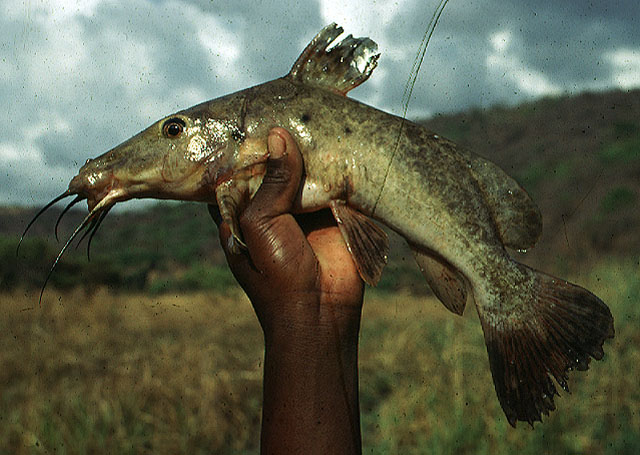| Claroteidae (Claroteid catfishes), subfamily: Auchenoglanidinae |
| 70 cm SL (male/unsexed) |
|
demersal; pH range: 6.5 - 7.80000019073486; dH range: 28, potamodromous |
| Africa: present in most rivers of West Africa, Lake Chad, the entire Congo River system, the Nile, East African lakes, and the rivers Omo and Giuba. |
|
Dorsal spines (total): 2; Dorsal soft rays (total): 7-8; Anal spines: 3-4; Anal soft rays: 6-8. Diagnosis: head width usually less than 2/3 of standard length, snout length more than 0.9 times the head width in adults (less in juveniles); hind margin of adipose fin rounded; premaxillary dentition forming (in adults) two close-set oval plates; maxillary barbel often blackish and only rarely reaching to anterior margin of opercule; 8-12 (usually 10 or 11) gill rakers on lower limb of first gill arch; palatine membrane with multiple invaginations, 1-4 of them forming longer lobes; dorsal margin of cleithral process ending in a point (visible only in adults)(Ref. 57126).
Description: body rather deep, a little less robust than Auchenoglanis biscutatus (body depth comprised 4.5-5 times in standard length); occipital process broad, rounded, contiguous to first nuchal plate, the ratio width/length 0.9 (juveniles) to 1.6 (adults); dorsal fin with 2 spines, the first small, the second strong and denticulate; adipose fin large, increasing in height backwards, its posterior margin rounded; palatine membrane with many well differentiated lobes; dorsal process of cleithrum with an upward-directed point (visible only in adults); premaxillary dentition forming a small band in juveniles (twice as long as broad), developing with growth into 2 close-set, kidney-shaped plates, the entire band being 1.0-1.3 times as long as large; head less broad (width 59-64% of length in juveniles and 61-68% in adults), snout short (48-55% of head length) in juveniles, but elongate (57-63% of head length) in adults; nasal barbels absent; pelvic fin with 1 unbranched and 5 branched soft rays (Ref. 57126). Anal fin with 3-4 unbranched and 7-8 branched soft rays (Ref. 681).
Coloration: body marbled in juveniles, with 7-8 transverse series of black spots, uniformly brown in adults; fins also marbled in juveniles; uniformly brownish, sometimes with large, rounded, poorly defined, dark brown spots in adults (Ref. 57126). |
| Inhabits lakes and large rivers (Ref. 4967), but has never been observed in large quantities in forested areas (Ref. 57126). Occurs in shallow water with muddy bottom. Omnivore, feed on plankton, mollusks, seeds and detritus (Ref. 13868). Oviparous (Ref. 205). Nested eggs are guarded by the male parent (Ref. 47642). Furthermore, the male plays host to eggs and young of Dinotopterus cunningtoni which takes advantage of the already prepared nest and feed on the host brood (Ref. 49546). An example of interspecific brood care. |
|
(Ref. 96402)
|
| harmless |
|
Source and more info: www.fishbase.org. For personal, classroom, and other internal use only. Not for publication.
Page created by Jen, 05.08.02,
php script by kbanasihan 06/09/2010 ,
last modified by
dsantos, 20/08/10

